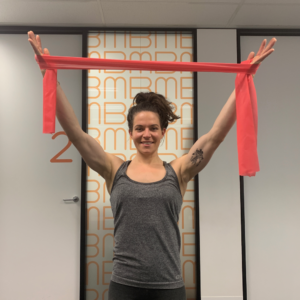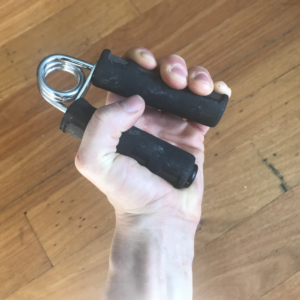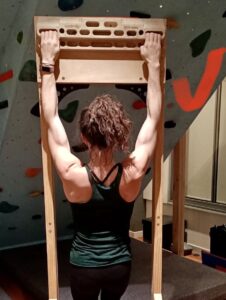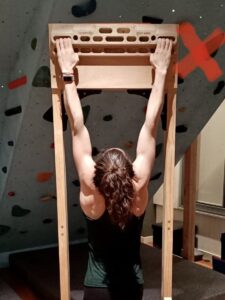Part Two of this three-part series on hangboarding focuses on warm-up, injury prevention and technique. Click here for Part One – Getting Started and Part Three – Finger Injury Management.
Before you start hangboarding it is essential to warm up the body. The flexor tendons in your hands are small and prone to injury so it is important to increase the blood flow, move the joints through full range of motion and gradually add load to increase the pliability of the flexor tendons so they can absorb force.
Good hangboard technique involves engaged shoulder and elbow position so it is important to activate the muscles in the shoulders (and no this does not mean just stretching!) as well as move the elbow through full range of motion under gentle load.
Warm-Up Exercises:
Below are two of my favourite shoulder warms ups. Preform 10×2 reps of each exercise and you should feel the back of your shoulders getting worked and warmed.
- Hold the theraband with palms facing you. Keep shoulders away from ears and slowly lift both hands over head keeping tension on the band making a V shape.
- Hold band taut and raise arm at 45 degree angle with thumb up, keep shoulder blade drawn back
Elbow pain is a common complaint for climbers as the pulling and griping motion of climbing can exert high loads through the medial tendon of elbow. Slow controlled push ups are a great exercise to warm up the elbow and move it through full range of motion.
Lastly are the fingers, if you have a grip strength trainer or squishy ball squeeze 10×2 slowly the flex and extend the fingers rapidly to help increase blood flow to the area.
Now the fun part (Actually hangboarding!)
Hangboarding Technique:
- Ensure you are lined up below the board, even if that means bringing a chair to step off and avoid body swinging.
- Hang with shoulders back and down, elbows a little bend and slightly facing toward each other, core engaged and keep eye gaze forward.
- Ease on and off the hangboard. Place your fingers on the holds and slowly take body weight away by lifting your feet. Avoid losing control and slipping off even during high intensity session (for more advanced climbers adding weight or on small holds).
- If you are new to hangboarding, take your time and get used to it! Have a few days between sessions to adjust to the increase in load. Best to only hangboard once a week if new and twice with more experience.
- Keep track of the holds you are using, how long you are holding and the sets you can do. Hangboarding can be a bit dull and the improvements can be overlooked unless you track your time and intensity.
There are different grips to train while using the hangboard which replicate the different holds when climbing. These include slopers, jugs, monos, pockets and the traditional open hand (drag), half crimp, full crimp. The variety can be overwhelming but essentially, you want to train what holds you will use the most and the grip that has the most transferability to other holds.
There is a huge variety of hangboard protocols available from beginners to advanced. For all programs keep in mind some key guidelines:
- Muscles can respond to training in a few weeks. It takes much longer for connective tissue in the fingers to adapt to increasing loads. Be patient and give yourself time to recover and adjust to new training method.
- Let hangboard be isolated to finger strength training, adding pull ups or lock of training should be done separately on a pull up bar.
- Difficulty can be increased by adding weight, such as 5kgs+ to your harness, or reducing the size that you are holding. This is called progressive overload. It is advised to only increase difficulty through either increased weight or reduce size of hold in each training cycle.
- Hangboard is supplemental to training. Focus on skill and climbing as your main point of improvement.
- The best program is the one you actually do consistently!
The last point is key. Hangboarding once a month will not get the adaptations you need. Find a way to make hangboarding enjoyable and you are well on your way to your next highest red point.
Resources
Schweizer A. Sport climbing from a medical point of view. Swiss Med Wkly. 2012;142:w13688. Published 2012 Oct 11. doi:10.4414/smw.2012.13688
Goddard, D., & Neumann, U. (1993). Performance rock climbing. Stackpole Books.
Fleming, R. K., & Hörst, E. J. (2010). Behavior analysis and sports climbing. Journal of Behavioral Health and Medicine, 1(2), 143.
https://www.tensionclimbing.com/hangboarding-a-way
Davis, C. M. (2004). A comparison of training methods for enhancing climbing performance (Doctoral dissertation, Montana State University-Bozeman, College of Education, Health & Human Development).










